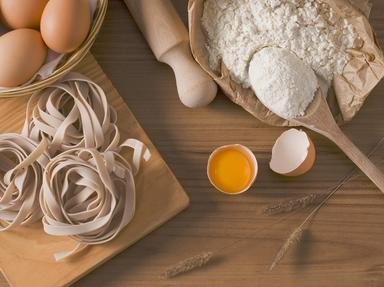Quiz Answer Key and Fun Facts
1. Many games, such as backgammon and Monopoly, involve the use of dice. Andrew Dice Clay is an American stand-up comedian. A dicey situation is a dangerous or risky one. What does it mean to dice food?
2. Chef notices that one of the equipment racks has become disorganized and asks you to straighten it out. On the shelf you find a colander, a wire-mesh sieve, a chinoise, a bain-marie, a China cap, and a tamis. Which is out of place?
3. The novelties of Italian pasta include the myriads of shapes and the inventive, sometimes fanciful, names by which they are known. Why are orecchiette called orecchiette?
4. Chef read a book about medieval European cookery and has determined to make some modern dishes with verjuice (or verjus). What on earth does he want to use?
5. How many tablespoons are there in one U.S. 4-ounce (113.4 gram) stick of butter?
6. A chum returns from vacation raving about "loco moco" which he tasted for the first time. What on earth is loco moco?
7. Several citrus fruits may be served with a grapefruit spoon. What makes this spoon different from any other spoon?
8. A visiting chef from Oaxaca wanted to test your knowledge of Mexican ingredients. She asked "What's the difference between a tomato and a tomatillo?" What is the difference?
9. Mace Windu is a Jedi Master portrayed in "Star Wars" films by Samuel L. Jackson. A mace is also a ceremonial club (weapon) used to denote that parliamentary assemblies are in session. Mace is also a brand of tear gas in an aerosol spray can. Chef suggests that you season the cream of acorn squash soup with mace. Of what is culinary mace made?
10. You are following a recipe which requires you to beat eggs and sugar together until the mixture reaches "the ribbon stage." What, exactly, is this "ribbon stage" to which the recipe confidently refers?
Source: Author
FatherSteve
This quiz was reviewed by FunTrivia editor
WesleyCrusher before going online.
Any errors found in FunTrivia content are routinely corrected through our feedback system.


